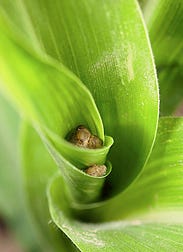Beneficial Mold Packaged in Bioplastic
March 11, 2015
Aflatoxins are highly toxic car
USDA.jpg
cinogens produced by several species of Aspergillus fungi. But not all Aspergillus produce aflatoxin. Some, in fact, are considered beneficial. One such strain, dubbed K49, is now being recruited to battle these harmful Aspergillus relatives, preventing them from contaminating host crops like corn with the carcinogen.
In collaboration with University of Bologna (UB) scientists in Italy, U.S. Department of Agriculture (USDA) scientists Hamed Abbas and Bob Zablotowicz (retired) have devised a new method of applying K49 as a frontline defense against aflatoxin contamination in corn, which causes an estimated $200 million annually in U.S. losses alone.
K49 is known as non-toxigenic (atoxigenic) because it cannot produce aflatoxin, unlike toxigenic strains of A. flavus and A. parasiticus that do. However, K49 is adept at excluding these aflatoxin-producing (toxigenic) "cousins" from ecological niches and resources that both need to survive. Exploiting this rivalry, called bio-competitive exclusion, offers an effective way to diminish aflatoxin levels in soil and in corn kernels.
Abbas is a plant pathologist and lead scientist with the Biological Control of Pests Research Unit, operated in Stoneville, Miss., by the Agricultural Research Service (ARS), USDA's chief intramural scientific research agency. This research supports the USDA priority of ensuring food safety.
Unlike the wheat and barley grains now used as carriers to apply commercial strains of biocompetitive Aspergillus molds, Abbas and UB colleague Cesare Accinelli encapsulated K49 in bioplastic granules made of corn starch and other environmentally friendly ingredients.
According to Abbas, the bioplastic granules improve the beneficial mold's storage life and viability once applied. And because wheat and barley grains are not used as carriers, seed-hungry animals like rats and birds avoid eating the bioplastic granules, giving K49 a chance to release its spores for dispersal to corn plants via wind or insect activity.
In tests, applications of the bioplastic-coated K49 reduced aflatoxin levels by 65 to 97 percent. The scientists' research was published in 2011 in the journal Crop Protection. The technology may also prove useful in delivering other beneficial fungi used to safeguard crops from disease, adds Abbas.
About the Author(s)
You May Also Like


